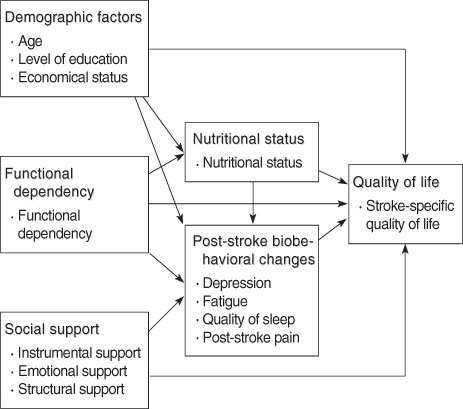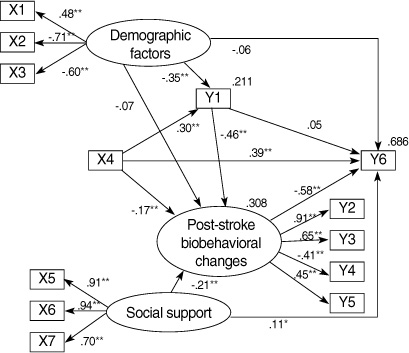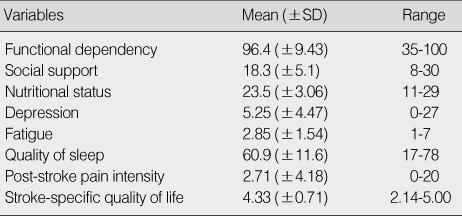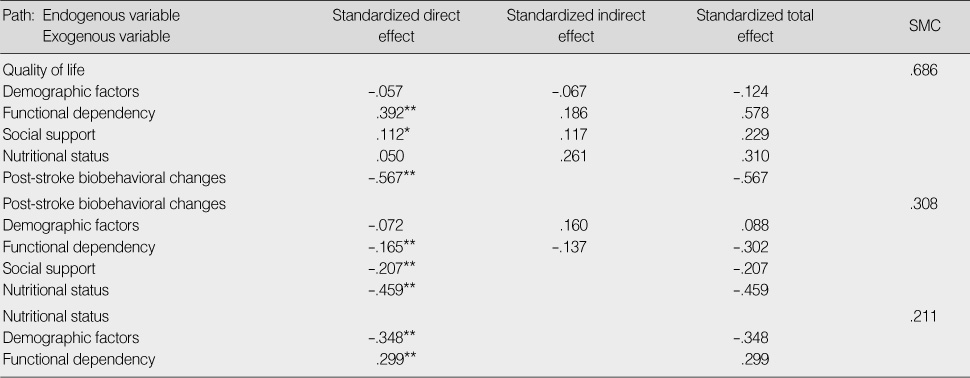Articles
- Page Path
- HOME > J Korean Acad Nurs > Volume 40(4); 2010 > Article
-
Original Article
- Structural Equation Modeling on Quality of Life in Stroke Survivors
- Minhee Suh, Smi Choi-Kwon
-
Journal of Korean Academy of Nursing 2010;40(4):533-541.
DOI: https://doi.org/10.4040/jkan.2010.40.4.533
Published online: August 31, 2010
1Researcher, Research Institute of Nursing Science, Seoul National University, Seoul, Korea.
2Professor, College of Nursing, Seoul National University, Seoul, Korea.
- Address reprint requests to: Choi-Kwon, Smi. College of Nursing, Seoul National University, 28 Yeongeon-dong, Jongno-gu, Seoul 110-460, Korea. Tel: 82-2-740-8830, Fax: 82-2-766-1852, smi@snu.ac.kr
• Received: May 24, 2010 • Accepted: August 13, 2010
Copyright © 2010 Korean Society of Nursing Science
Abstract
-
Purpose
- This study was designed to test structural equation modeling of the quality of life of stroke survivors in order to provide guidelines for development of interventions and strategies to improve their quality of life.
-
Methods
- The participants in the study were patients who visited the neurology outpatient department of a tertiary hospital in Seoul between June 25 and October 15, 2009. Data collection was carried out through one-on-one interviews. Demographic factors, functional independence, social support, nutritional status, post-stroke biobehavioral changes and quality of life were investigated.
-
Results
- The final analysis included 215 patients. Fitness of the hypothetical model was appropriate (χ2=111.5, p=.000, GFI=.926, AGFI=.880, RMSA=.068, NFI=.911, CFI=.953). Functional dependency, social support and post-stroke biobehavioral changes were found to be significant explaining variance in quality of life. Post-stroke biobehavioral changes had the strongest direct influence on quality of life. Nutritional status had an indirect effect on the quality of life.
-
Conclusion
- To improve the quality of life of stroke survivors, comprehensive interventions are necessary to manage post-stroke biobehavioral changes, and strengthening social support networks that can contribute to enhancing the quality of life of stroke survivors.
This article is a condensed form of the first author's doctoral thesis from Seoul National University.
- 1. Alves de Rezende CH, Coelho LM, Oliveira LM, Penha SN. Dependence of the geriatric depression scores on age, nutritional status, and haematologic variables in elderly institutionalized patients. The Journal of Nutrition, Health & Aging. 2009;13:617–621.ArticlePDF
- 2. Carod-Artal FJ, Egido JA. Quality of life after stroke: The importance of a good recovery. Cerebrovascular Disease. 2009;27:204–214.ArticlePDF
- 3. Carod-Artal FJ, Ferreira Coral L, Trizotto DS, Menezes Moreira C. Poststroke depression: Prevalence and determinants in Brazilian stroke patients. Cerebrovascular Disease. 2009;28:157–165.ArticlePDF
- 4. Carod-Artal J, Egido A, González L, Varela de Seijas E. Quality of life among stroke survivors evaluated 1 year after stroke. Stroke. 2000;31:2995–3000.ArticlePubMed
- 5. Chang S, Park Y, Youn J. Study on relations of variables-attributions of somatic symptoms, fatigue, chronic pain and depression in the elderly. Journal of Korean Academy of Nursing. 2003;33:26–33.ArticlePubMedPDF
- 6. Choi-Kwon S, Choi J, Kwon S, Kang D, Kim J. Factors that affect the quality of life at 3 year post-stroke. Journal of Clinical Neurology. 2006;2:34–41.PubMedPMC
- 7. Choi-Kwon S, Han S, Kwon S, Kim J. Poststroke fatigue: Characteristics and related factors. Cerebrovascular Disease. 2005;19:84–90.ArticlePDF
- 8. Choi-Kwon S, Kim H, Kwon S, Kim J. Factors affecting the burden on caregivers of stroke survivors in South Korea. Archives of Physical Medicine and Rehabilitation. 2005;86:1043–1048.ArticlePubMed
- 9. Gonzales R. Central pain: Diagnosis and treatment strategies. Neurology. 1995;45:12 Suppl 9. S11–S16.
- 10. Guigoz Y, Vellas B, Garry P. Assessing the nutritional status of the elderly: The mini nutritional assessment as part of the geriatric evaluation. Nutrition reviews. 1996;54:S59–S65.Article
- 11. Kim E, Lee J. Factors influencing health-related quality of life in elderly who visited a senior center: With activity of daily living, quality of sleep and depression. Journal of the Korean Gerontological Society. 2009;29:425–440.
- 12. Kim H, Park Y. A study on life style, functional condition, depression and perceived health status of stroke patient at home. Journal of the Korean Public Health Association. 2003;29:127–139.
- 13. Kim I, Seo M, Kim K, Cho N. The Relationship between the characteristics of social support and post-stroke depression. Korean Journal of Rehabilitation Nursing. 1999;2:206–214.
- 14. Kim J. Post-stroke depression, anxiety, emotional incontinence, anger proness and fatigue. Journal of the Korean Neurological Association. 2005;23:1–8.
- 15. Kim J, Choi-Kwon S. Poststroke depression and emotional incontinence: Correlation with lesion location. Neurology. 2000;54:1805–1810.ArticlePubMed
- 16. Kim J, Kang H, Kim W, Wang M, Chang C. Factors affecting the quality of life in stroke patient at home. Korean Journal of Rehabilitation Nursing. 2006;9:49–55.
- 17. Klit H, Finnerup N, Jensen T. Central post-stroke pain: Clinical characteristics, pathophysiology, and management. Lancet Neurology. 2009;8:857–868.ArticlePubMed
- 18. Kohatsu W. Nutrition and depression. Explore. 2005;1:474–476.ArticlePubMed
- 19. Lee H. Adjustment of middle-aged people with hemiplegia after stroke. 2006;Seoul, Seoul National University. Unpublished doctoral dissertation.
- 20. Lee H, Lim J. Structural equation modeling and AMOS 16.0. 2009;Seoul, Bupmoonsa.
- 21. Lee M, Choh A, Demerath E, Knutson K, Duren D, Sherwood R, et al. Sleep disturbance in relation to health-related quality of life in adults: The Fels Longitudinal Study. The Journal of Nutrition, Health & Aging. 2009;13:576–583.ArticlePDF
- 22. Lee S, Chung H. Brain neurologic disorder and depression in elderly. Journal of Korean Geriatric Psychiatry. 2003;7:131–142.
- 23. Leppavuori A, Pohjasvaara T, Kaste M, Erkinjuntti T. Insomnia in ischemic stroke patients. Cerebrovascular Disease. 2002;14:90–97.ArticlePDF
- 24. Lim S. Structural model for quality of life in stroke patients. 2002;Seoul, Kyung Hee University. Unpublished doctoral dissertation.
- 25. Mitchell P, Powell L, Blumenthal J, Norten J, Ironson G, Pitula C, et al. A short social support measure for patients recovering from myocardial infarction: The ENRICHD Social Support Inventory. Journal of Cardiopulmonary Rehabilitation. 2003;23:398–403.ArticlePubMed
- 26. Park J, Kwon Y. Standardization of Korean version of Mini-Mental State Examination. Journal of Neuropsychiatry Association. 1989;28:508–513.
- 27. Skilbeck C, Wade D, Hewer R, Wood V. Recovery after stroke. Journal of Neurology, Neurosurgery, and Psychiatry. 1983;46:5–8.ArticlePubMedPMC
- 28. Snyder-Halpern R, Verran J. Instrumentation to describe subjective sleep characteristics in healthy subjects. Research in Nursing & Health. 1987;10:155–163.Article
- 29. So W, Marsh G, Ling W, Leung F, Lo J, Yeung M, et al. The symptom cluster of fatigue, pain, anxiety and depression and the effect on the quality of life of women receiving treatment for breast cancer: A multicenter study. Oncology Nursing Forum. 2009;36:E205–E214.ArticlePubMed
- 30. Staub F, Bogousslavsky S. Post-stroke depression or fatigue? European Neurology. 2001;45:3–5.ArticlePubMedPDF
- 31. Sterr A, Herron K, Dijk D, Ellis J. Time to wake-up: Sleep problems and daytime sleepiness in long-term stroke survivors. Brain Injury. 2008;22:575–579.ArticlePubMed
- 32. Suh M, Choi-Kwon S. Sleep-wake disturbance in post-stroke patients. Journal of Korean Biological Nursing Science. 2009;11:23–31.
- 33. UNC Biobehavioral laboratory. 2008;School of Nursing. University of North Carolina. from http://nursing.unc.edu/departments/research/bbl/index.html.
- 34. Van de Port I, Kwakkel G, Schepers V, Heinemans C, Lindeman E. Is fatigue an independent factor associated with activities of daily living, instrumental activities of daily living and health-related quality of life in chronic stroke? Cerebrovascular Disease. 2007;23:40–45.ArticlePDF
- 35. Whyte E, Mulsant B. Post stroke depression: Epidemiology, pathophysiology and biological treatment. Biological psychiatry. 2002;52:253–264.ArticlePubMed
- 36. Williams L, Weinberger M, Harris L, Clark D, Biller J. Development of a stroke-specific quality of life scale. Stroke. 1999;30:1362–1369.ArticlePubMed
- 37. Winward C, Sackley C, Metha Z, Rothwell P. A population-based study of the prevalence of fatigue after transient ischemic attack and minor stroke. Stroke. 2009;40:757–761.ArticlePubMed
REFERENCES
Figure 2
Path diagram for the hypothetical model.
*p<.05; **p<.01.
X1=Age; X2=Level of education; X3=Economical status; X4=Functional dependency; X5=Instrumental support; X6=Emotional support; X7=Structural support; Y1=Nutritional status; Y2=Depression; Y3=Fatigue; Y4=Quality of sleep; Y5=Post-stroke pain; Y6=Quality of life.


Figure & Data
REFERENCES
Citations
Citations to this article as recorded by 

- Predictors of long‐term medication adherence in stroke survivors: A multicentre, prospective, longitudinal study
Sung‐Hee Yoo, Gye‐Gyoung Kim, Sung Reul Kim, Man‐Seok Park, Joon‐Tae Kim, Kang‐Ho Choi, Hyun‐Young Park, Sang‐Hak Yi, Jae‐Kwan Cha, Dae‐Hyun Kim, Hyun‐Wook Nah
Journal of Clinical Nursing.2023; 32(1-2): 58. CrossRef - Factors Related to Beliefs about Medication in Ischemic Stroke Patients
Gye-Gyoung Kim, Sung-Hee Yoo, Man-Seok Park, Hyun-Young Park, Jae-Kwan Cha
Journal of Clinical Medicine.2022; 11(13): 3825. CrossRef - Is post-ischemic stroke insomnia related to a negative functional and cognitive outcome?
Andreia Matas, Luísa Amaral, Assunção Vaz Patto
Sleep Medicine.2022; 94: 1. CrossRef - A prediction model of health‐related quality of life in young adult patients with stroke
Susie Yoon, Hye Young Kim, Sung Reul Kim
Journal of Clinical Nursing.2021; 30(13-14): 2023. CrossRef - Factors related to Bowel Cleanliness of Colonoscopy Examinees
Yohan Lee, Haejung Lee
Korean Journal of Adult Nursing.2021; 33(6): 545. CrossRef - Predictive Model for Quality of Life in Patients 1 Year After First Stroke
Sung Reul Kim, Sung-Hee Yoo, Hye Young Kim, Gye-Gyoung Kim
Journal of Cardiovascular Nursing.2021; 36(5): E60. CrossRef - Incidence and prevalence of post-stroke insomnia: A systematic review and meta-analysis
Satu Baylan, Susan Griffiths, Nicola Grant, Niall M. Broomfield, Jonathan J. Evans, Maria Gardani
Sleep Medicine Reviews.2020; 49: 101222. CrossRef - Factors Influencing 1-Year Medication Adherence of Korean Ischemic Stroke Survivors
Gye-Gyoung Kim, Duck-Hee Chae, Man-Seok Park, Sung-Hee Yoo
International Journal of Behavioral Medicine.2020; 27(2): 225. CrossRef - Factors Associated to Returning Home in the First Year after Stroke
Seung Han Kim, Yong-Il Shin, Seung Chan Kim, Sung Hwa Ko, Deog Young Kim, Jongmin Lee, Min Kyun Sohn, Sam-Gyu Lee, Gyung-Jae Oh, Yang-Soo Lee, Min Cheol Joo, Eun Young Han, Junhee Han, Won Hyuk Chang, Ji Hong Min, Yun-Hee Kim
Brain & Neurorehabilitation.2020;[Epub] CrossRef - Meta-Analysis of Social Psychological Factors related to Quality of Life in Stroke Patients
Young-Ok Yang, Minju Kim, Kyung-Yeon Park
Journal of Korean Academy of Community Health Nursing.2018; 29(4): 510. CrossRef - Characteristics and Factors related to Fatigue in Older Adults at a Senior Welfare Center
Su Yeon Jeong, Smi Choi-Kwon
Korean Journal of Adult Nursing.2018; 30(5): 516. CrossRef - Musculoskeletal and central pain at 1 year post-stroke: associated factors and impact on quality of life
S. Choi-Kwon, S. H. Choi, M. Suh, S. Choi, K.-H. Cho, H.-W. Nah, H. Song, J. S. Kim
Acta Neurologica Scandinavica.2017; 135(4): 419. CrossRef - Structural equation modeling of the quality of life for patients with marfan syndrome
Ju Ryoung Moon, Yong Ae Cho, June Huh, I-Seok Kang, Duk-Kyung Kim
Health and Quality of Life Outcomes.2016;[Epub] CrossRef - A Study about the Quality of Life and QALYs of Stroke Patients according to the Medical Care Utilization Behavior: Findings from the 2009–2012 Korea Health Panel Data
Seong-Bong Park, Tae-Woong Uhm, Nam-Kwen Kim
Journal of Korean Medicine.2016; 37(1): 41. CrossRef - Factors Associated with Poststroke Fatigue: A Systematic Review
Amélie Ponchel, Stéphanie Bombois, Régis Bordet, Hilde Hénon
Stroke Research and Treatment.2015; 2015: 1. CrossRef - Modeling health-related quality of life in people recovering from stroke
Nancy E. Mayo, Susan C. Scott, Mark Bayley, Angela Cheung, Jayne Garland, Jeffrey Jutai, Sharon Wood-Dauphinee
Quality of Life Research.2015; 24(1): 41. CrossRef - Sleep Disturbances After Cerebral Infarction: Role of Depression and Fatigue
Minhee Suh, Smi Choi-Kwon, Jong S. Kim
Journal of Stroke and Cerebrovascular Diseases.2014; 23(7): 1949. CrossRef - The Effect of Functional Dependency and Stress on Health-related Quality of Life in Patients under Rehabilitation after Stroke
Ok-Hee Cho, Suyoung Choi, Jihyeun Song
Journal of muscle and joint health.2013; 20(2): 81. CrossRef
Structural Equation Modeling on Quality of Life in Stroke Survivors


Figure 1
Research framework.
Figure 2
Path diagram for the hypothetical model.
*p<.05; **p<.01.
X1=Age; X2=Level of education; X3=Economical status; X4=Functional dependency; X5=Instrumental support; X6=Emotional support; X7=Structural support; Y1=Nutritional status; Y2=Depression; Y3=Fatigue; Y4=Quality of sleep; Y5=Post-stroke pain; Y6=Quality of life.
Figure 1
Figure 2
Structural Equation Modeling on Quality of Life in Stroke Survivors
Descriptive Statistics of Observed Variables, (N=215)
Correlations among Observed Variables
*p<.05; **p<.01.
Standardized Direct, Indirect and Total Effects for the Hypothetical Model
*p<.05; **p<.01. SMC=Squared multiple correlations.
Table 1
Descriptive Statistics of Observed Variables, (N=215)
Table 2
Correlations among Observed Variables
*
Table 3
Standardized Direct, Indirect and Total Effects for the Hypothetical Model
*
 KSNS
KSNS
 E-SUBMISSION
E-SUBMISSION




 Cite
Cite

